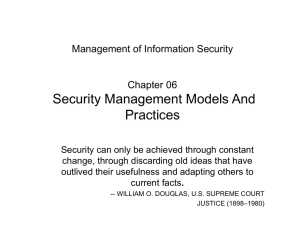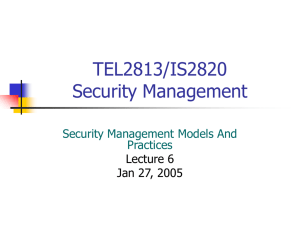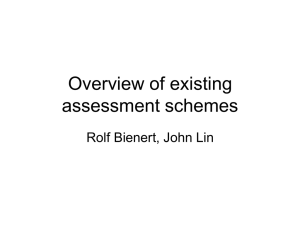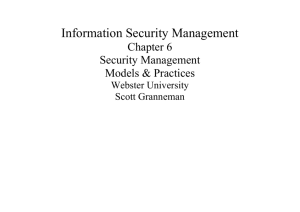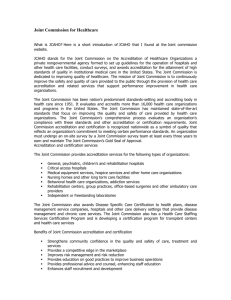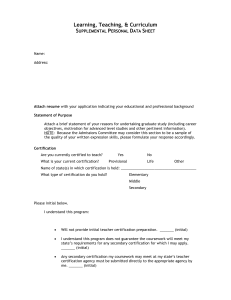Chapter 1
advertisement
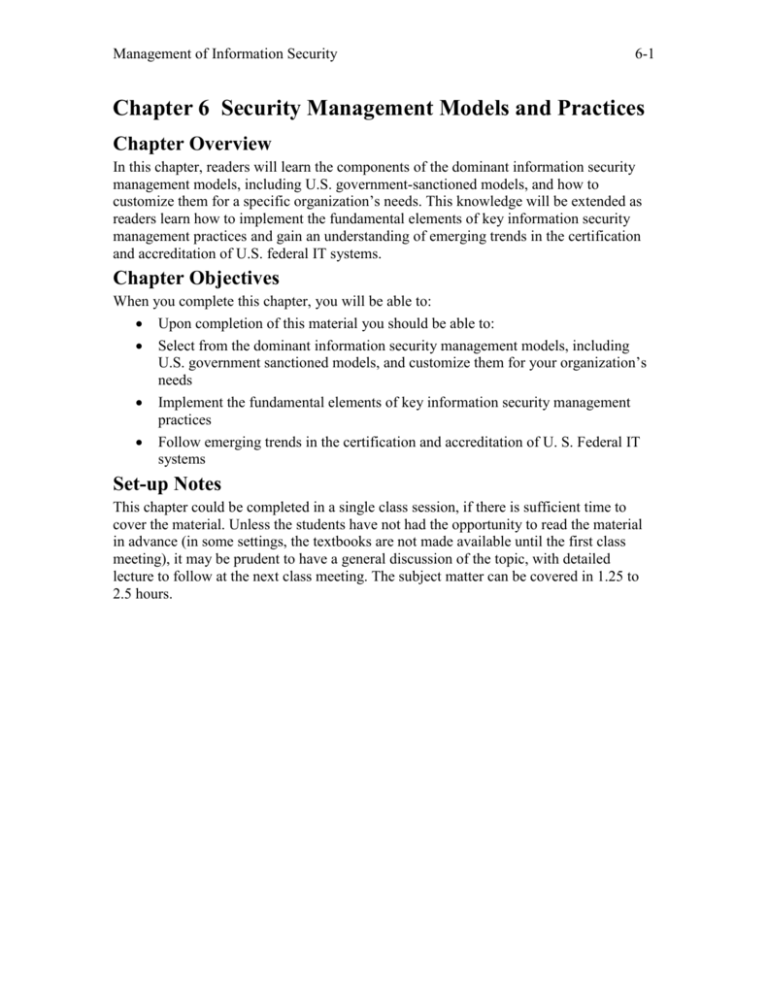
Management of Information Security 6-1 Chapter 6 Security Management Models and Practices Chapter Overview In this chapter, readers will learn the components of the dominant information security management models, including U.S. government-sanctioned models, and how to customize them for a specific organization’s needs. This knowledge will be extended as readers learn how to implement the fundamental elements of key information security management practices and gain an understanding of emerging trends in the certification and accreditation of U.S. federal IT systems. Chapter Objectives When you complete this chapter, you will be able to: Upon completion of this material you should be able to: Select from the dominant information security management models, including U.S. government sanctioned models, and customize them for your organization’s needs Implement the fundamental elements of key information security management practices Follow emerging trends in the certification and accreditation of U. S. Federal IT systems Set-up Notes This chapter could be completed in a single class session, if there is sufficient time to cover the material. Unless the students have not had the opportunity to read the material in advance (in some settings, the textbooks are not made available until the first class meeting), it may be prudent to have a general discussion of the topic, with detailed lecture to follow at the next class meeting. The subject matter can be covered in 1.25 to 2.5 hours. Management of Information Security 6-2 Lecture Notes and Teaching Tips with Quick Quizzes Introduction To create or maintain a secure environment, one must design a working security plan and then implement a management model to execute and maintain the plan. This may begin with the creation or validation of a security framework, followed by an information security blueprint that describes existing controls and identifies other necessary security controls. A framework is the outline of the more thorough blueprint, which is the basis for the design, selection, and implementation of all subsequent security controls. Introduction To design a security blueprint, most organizations draw from established security models and practices. Security Management Models A security model is a generic blueprint offered by a service organization. One way to create the blueprint is to look at what other organizations have done (benchmarking). One way to select a methodology is to adapt or adopt an existing security management model or set of practices. BS 7799 Part 1 One of the most widely referenced and often discussed security models is Information Technology – Code of Practice for Information Security Management, which was originally published as British Standard BS 7799. The purpose of ISO/IEC 17799 is to “give recommendations for information security management for use by those who are responsible for initiating, implementing or maintaining security in their organization. It is intended to provide a common basis for developing organizational security standards and effective security management practice and to provide confidence in interorganizational dealings.” Volume 2 provides information on how to implement Volume 1 (17799) and how to set up an Information Security Management Structure (ISMS). Management of Information Security 6-3 ISO/IEC 17799 1 Drawbacks 1. The global information security community has not defined any justification for a code of practice as identified in the ISO/IEC 17799 2. ISO/IEC 17799 lacks “the necessary measurement precision of a technical standard” 3. There is no reason to believe that ISO/IEC 17799 is more useful than any other approach 4. ISO/IEC 17799 is not as complete as other frameworks 5. ISO/IEC 17799 is perceived to have been hurriedly prepared, given the tremendous impact its adoption could have on industry information security controls Management of Information Security 6-4 The Ten Sections of ISO/IEC 17799 1. Organizational Security Policy is needed to provide management direction and support for information security. 2. Organizational Security Infrastructure objectives include: Manage information security within the company Maintain the security of organizational information processing facilities and information assets accessed by third parties Maintain the security of information when the responsibility for information processing has been outsourced to another organization 3. Asset Classification and Control is needed to maintain appropriate protection of corporate assets and to ensure that information assets receive an appropriate level of protection. 4. Personnel Security objectives are: Reduce risks of human error, theft, fraud or misuse of facilities Ensure that users are aware of information security threats and concerns, and are equipped to support the corporate security policy in the course of their normal work Minimize the damage from security incidents and malfunctions and learn from such incidents 5. Physical and Environmental Security objectives include: Prevent unauthorized access, damage and interference to business premises and information Prevent loss, damage or compromise of assets and interruption to business activities Prevent compromise or theft of information and information processing facilities 6. Communications and Operations Management objectives are: Ensure the correct and secure operation of information processing facilities Minimize the risk of systems failures Protect the integrity of software and information Maintain the integrity and availability of information processing and communication Ensure the safeguarding of information in networks and the protection of the supporting infrastructure Prevent damage to assets and interruptions to business activities Prevent loss, modification or misuse of information exchanged between organizations Management of Information Security 6-5 7. System Access Control objectives in this area include: Control access to information Prevent unauthorized access to information systems Ensure the protection of networked services Prevent unauthorized computer access Detect unauthorized activities Ensure information security when using mobile computing and telecommunication networks 8. System Development and Maintenance objectives include: Ensure security is built into operational systems Prevent loss, modification or misuse of user data in application systems Protect the confidentiality, authenticity and integrity of information Ensure IT projects and support activities are conducted in a secure manner Maintain the security of application system software and data 9. Business Continuity Planning to counteract interruptions to business activities and to critical business processes from the effects of major failures or disasters. 10. Compliance objectives include: Avoid breaches of any criminal or civil law, statutory, regulatory or contractual obligations and of any security requirements Ensure compliance of systems with organizational security policies and standards Maximize the effectiveness of and minimize interference to/from the system audit process BS 7799 Part 2: Part 2 of BS 7799 provides implementation details using a Plan-Do-Check-Act cycle. Management of Information Security 6-6 The Security Management Index and ISO 17799 One way to determine how closely an organization is complying with ISO 17799 is to take the Human Firewall Council’s survey, the Security Management Index (SMI). The SMI asks 35 questions over the 10 domains of the ISO standard. “This survey gathers metrics on how organizations manage security and enables information security officers to benchmark their practices against those of other organizations. The survey has been developed according to ISO 17799 international security standards to reflect best practices from a global perspective. The Security Management Index survey will help you measure your security management practices compared to other organizations in your industry and peer group.” The Human Firewall Council recommends: Familiarize yourself with the 10 categories of security management. Benchmark your organization’s security management practices by taking the survey. Evaluate your results in each category to identify strengths and weaknesses. Examine the suggestions for improvement in each category in this report. Management of Information Security 6-7 Use your SMI results to gain support for improving security. RFC 2196 Site Security Handbook The Security Area Working Group within the IETF has created RFC 2196. The Security Area Working Group acts as an advisory board for the protocols and areas developed and promoted through the Internet Society. RFC 2196: Site Security Handbook does provide a good functional discussion of important security issues and provides an overview of five basic areas of security, along with development and implementation details. There are chapters on such important topics as security policies, security technical architecture, security services, and security incident handling. The architecture chapter begins with a discussion of the importance of security policies, and expands into an examination of services, access controls, and other relevant areas. NIST Security Models NIST documents have two notable advantages: They are publicly available at no charge; and they have been available for some time and thus have been broadly reviewed by government and industry professionals. SP 800-12, Computer Security Handbook SP 800-14, Generally Accepted Security Principles & Practices SP 800-18, Guide for Developing Security Plans SP 800-26, Security Self-Assessment Guide-IT Systems SP 800-30, Risk Management for Information Technology Systems NIST SP 800-12 SP 800-12 is entitled The Computer Security Handbook, and is an excellent reference and guide for the routine management of information security. It provides little guidance, however, on design and implementation of new security systems; use it as a supplement to gain a deeper understanding in the background and terminology. 800-12 also lays out the NIST philosophy on security management by identifying 17 controls organized into three categories: The Management Controls section addresses security topics that can be characterized as managerial. The Operational Controls section addresses security controls that focus on controls that are, broadly speaking, implemented and executed by people (as opposed to systems). The Technical Controls section focuses on security controls that the computer system executes. Management of Information Security 6-8 NIST Special Publication 800-14 NIST SP800-14, subtitled Generally Accepted Principles and Practices for Securing Information Technology Systems, describes best practices and provides information on commonly accepted information security principles that can direct the security team in the development of a security blueprint. It also describes the philosophical principles that the security team should integrate into the entire information security process, expanding upon the components of SP 800-12. The more significant points made in NIST SP 800-14 are as follows: 1) Security Supports the Mission of the Organization. 2) Security is an Integral Element of Sound Management. 3) Security Should Be Cost-Effective 4) Systems Owners Have Security Responsibilities Outside Their Own Organizations. 5) Security Responsibilities and Accountability Should Be Made Explicit. 6) Security Requires a Comprehensive and Integrated Approach. 7) Security Should Be Periodically Reassessed. 8) Security is Constrained by Societal Factors. It enumerates 33 principles for Securing Information Technology Systems: Principle 1. Establish a sound security policy as the “foundation” for design. Principle 2. Treat security as an integral part of the overall system design. Principle 3. Clearly delineate the physical and logical security boundaries governed by associated security policies. Principle 4. Reduce risk to an acceptable level. Principle 5. Assume that external systems are insecure. Principle 6. Identify potential trade-offs between reducing risk and increased costs and decrease in other aspects of operational effectiveness. Principle 7. Implement layered security (Ensure no single point of vulnerability). Principle 8. Implement tailored system security measures to meet organizational security goals. Principle 9. Strive for simplicity. Principle 10. Design and operate an IT system to limit vulnerability and to be resilient in response. Principle 11. Minimize the system elements to be trusted. Principle 12. Implement security through a combination of measures distributed physically and logically. Principle 13. Provide assurance that the system is, and continues to be, resilient in the face of expected threats. Principle 14. Limit or contain vulnerabilities. Principle 15. Formulate security measures to address multiple overlapping information domains. Management of Information Security 6-9 Principle 16. Isolate public access systems from mission critical resources. Principle 17. Use boundary mechanisms to separate computing systems and network infrastructures. Principle 18. Where possible, base security on open standards for portability and interoperability. Principle 19. Use common language in developing security requirements. Principle 20. Design and implement audit mechanisms to detect unauthorized use and to support incident investigations. Principle 21. Design security to allow for regular adoption of new technology, including a secure and logical technology upgrade process. Principle 22. Authenticate users and processes to ensure appropriate access control decisions both within and across domains. Principle 23. Use unique identities to ensure accountability. Principle 24. Implement least privilege. Principle 25. Do not implement unnecessary security mechanisms. Principle 26. Protect information while being processed, in transit, and in storage. Principle 27. Strive for operational ease of use. Principle 28. Develop and exercise contingency or disaster recovery procedures to ensure appropriate availability. Principle 29. Consider custom products to achieve adequate security. Principle 30. Ensure proper security in the shutdown or disposal of a system. Principle 31. Protect against all likely classes of “attacks.” Principle 32. Identify and prevent common errors and vulnerabilities. Principle 33. Ensure that developers are trained in how to develop secure software. NIST Special Publication 800-18 NIST SP 800-18 - A Guide for Developing Security Plans for Information Technology Systems, provides detailed methods for assessing, designing, and implementing controls and plans for various sized applications. SP 800-18 serves as a guide for the activities described in this chapter, and for the overall information security planning process. It includes templates for major application security plans. NIST Special Publication 800-26 Management Controls 1. Risk Management 2. Review of Security Controls 3. Life Cycle Maintenance 4. Authorization of Processing (Certification and Accreditation) 5. System Security Plan Operational Controls 6. Personnel Security Management of Information Security 6-10 7. Physical Security 8. Production, Input/Output Controls 9. Contingency Planning 10. Hardware and Systems Software 11. Data Integrity 12. Documentation 13. Security Awareness, Training, and Education 14. Incident Response Capability Technical Controls 15. Identification and Authentication 16. Logical Access Controls 17. Audit Trails NIST SP 800-26 - Security Self-Assessment Guide for Information Technology Systems describes seventeen areas that span managerial, operational and technical controls. The 17 areas listed are the core of the NIST security management structure. NIST Special Publication 800-30 NIST SP 800-30 - Risk Management Guide for Information Technology Systems provides a foundation for the development of an effective risk management program, containing both the definitions and the practical guidance necessary for assessing and mitigating risks identified within IT systems. The ultimate goal is to help organizations to better manage IT-related mission risks. Quick Quiz 1. What is a security blueprint? ANSWER: It is the basis for the design, selection, and implementation of all subsequent security controls. 2. The purpose for ISO/IEC 17799? ANSWER: Its purpose is to give recommendations for information security management for use by those who are responsible for initiating, implementing or maintaining security in their organization. Teaching Tip The NIST Publication list can be a bit daunting for students. Be sure to spend extra time using the names of the various pubs rather than relying solely on the numbers. The names are fairly descriptive and can help students recall what is in the various documents. Management of Information Security 6-11 Security Management Practices In information security, two categories of benchmarks are used: standards of due care/due diligence, and best practices. Best practices include a sub-category of practices—called the gold standard—that are general regarded as “the best of the best.” Standards of Due Care/Due Diligence When organizations adopt minimum levels of security for a legal defense, they may need to show that they have done what any prudent organization would do in similar circumstances; this is known as a standard of due care. Implementing controls at this minimum standard, and maintaining them, demonstrates that an organization has performed due diligence. Due diligence requires that an organization ensure that the implemented standards continue to provide the required level of protection. Failure to support a standard of due care or due diligence can expose an organization to legal liability, provided it can be shown that the organization was negligent in its application or lack of application of information protection. Best Security Practices Security efforts that seek to provide a superior level of performance in the protection of information are referred to as best business practices or simply best practices. Some organizations refer to these as recommended practices. Security efforts that are among the best in the industry are referred to as best security practices These practices balance the need for information access with the need for adequate protection. Best practices seek to provide as much security as possible for information and information systems while demonstrating fiscal responsibility and ensuring information access. Companies with best practices may not be the best in every area; they may only have established an extremely high quality or successful security effort in one area. VISA International Security Model VISA has developed two important documents that improve and regulate its information systems: The “Security Assessment Process” document contains a series of recommendations for the detailed examination of an organization’s systems with the eventual goal of integration into the VISA systems. The “Agreed Upon Procedures” document outlines the policies and technologies used to safeguard security systems that carry the sensitive cardholder information to and from VISA systems. Management of Information Security 6-12 The Gold Standard Best business practices are not sufficient for organizations that prefer to set the standard by implementing the most protective, supportive, and yet fiscally responsible standards they can. They strive toward the gold standard, a model level of performance that demonstrates industrial leadership, quality, and concern for the protection of information. The implementation of gold standard security requires a great deal of support, both in financial and personnel resources. Selecting Best Practices Choosing which recommended practices to implement can pose a challenge for some organizations. In industries that are regulated by governmental agencies, government guidelines are often requirements. For other organizations, government guidelines are excellent sources of information about what other organizations are required to do to control information security risks, and can inform their selection of best practices. Selecting Best Practices When considering best practices for your organization, consider the following: Does your organization resemble the identified target organization of the best practice? Are you in a similar industry as the target? Do you face similar challenges as the target? Is your organizational structure similar to the target? Are the resources you can expend similar to those called for by the best practice? Are you in a similar threat environment as the one assumed by the best practice? Microsoft has published a set of best practices in security at its Web site: Use antivirus software Use strong passwords Verify your software security settings Update product security Build personal firewalls Back up early and often Protect against power surges and loss Benchmarking and Best Practices Limitations The biggest problem with benchmarking in information security is that organizations don’t talk to each other; a successful attack is viewed as an organizational failure, and is kept secret, insofar as possible. However, more and more security administrators are joining professional associations and societies like ISSA and sharing their stories and lessons learned. An alternative to this direct dialogue is the publication of lessons learned. Management of Information Security 6-13 Baselining A baseline is a “value or profile of a performance metric against which changes in the performance metric can be usefully compared.” Baselining is the process of measuring against established standards. In InfoSec, baselining is the comparison of security activities and events against the organization’s future performance. Baselining can provide the foundation for internal benchmarking, as information gathered for an organization’s first risk assessment becomes the baseline for future comparisons. The Gartner group offers twelve questions as a self assessment for best security practices. People: 1) “Do you perform background checks on all employees with access to sensitive data, areas, or access points? 2) “Would the average employee recognize a security issue? 3) “Would they choose to report it? 4) “Would they know how to report it to the right people? Processes: 5) “Are enterprise security policies updated on at least an annual basis, employees educated on changes, and consistently enforced? 6) “Does your enterprise follow a patch/update management and evaluation process to prioritize and mediate new security vulnerabilities? 7) “Are the user accounts of former employees immediately removed on termination? 8) “Are security group representatives involved in all stages of the project life cycle for new projects? Baselining Technology: 9) “Is every possible route to the Internet protected by a properly configured firewall? 10) “Is sensitive data on laptops and remote systems encrypted? 11) “Do you regularly scan your systems and networks, using a vulnerability analysis tool, for security exposures? 12) “Are malicious software scanning tools deployed on all workstations and servers?” Quick Quiz 3. What are the two important documents VISA developed that improve and regulate its information systems t? ANSWER: The “Security Assessment Process” and the “Agreed Upon Procedures.” Management of Information Security 6-14 Emerging Trends in Certification and Accreditation In security management, accreditation is the authorization of an IT system to process, store, or transmit information. It is issued by a management official and serves as a means of assuring that systems are of adequate quality. It also challenges managers and technical staff to find the best methods to assure security, given technical constraints, operational constraints, and mission requirements. Certification is “the comprehensive evaluation of the technical and non-technical security controls of an IT system to support the accreditation process that establishes the extent to which a particular design and implementation meets a set of specified security requirements.” Organizations pursue accreditation or certification to gain a competitive advantage, or to provide assurance or confidence to customers. SP 800-37 Guidelines for the Security Certification and Accreditation of Federal IT systems. NIST promotes a new System Certification and Accreditation Project designed to: Develop standard guidelines and procedures for certifying and accrediting federal IT systems including the critical infrastructure of the United States Define essential minimum security controls for federal IT systems Promote the development of public and private sector assessment organizations and certification of individuals capable of providing cost effective, high quality, security certifications based on standard guidelines and procedures The specific benefits of the security certification and accreditation (C&A) initiative include: More consistent, comparable, and repeatable certifications of IT systems More complete, reliable, information for authorizing officials—leading to better understanding of complex IT systems and associated risks and vulnerabilities— and therefore, more informed decisions by management officials Greater availability of competent security evaluation and assessment services More secure IT systems within the federal government” This project is also designed to promote development of: A standardized process for certifying and accrediting Federal information systems including the critical infrastructure of the United States Minimum security controls for Federal information and IS supporting confidentiality, integrity, and availability Techniques and procedures for verifying the effectiveness of security controls for Federal IS Robust, automated tools supporting the certification and accreditation process Public and private sector assessment organizations capable of providing cost effective, high quality, certification services Management of Information Security 6-15 800-37 focuses on a three-step security controls selection process: Step 1: Characterize the System Step 2: Select the Appropriate Minimum Security Controls for the System Step 3: Adjust Security Controls Based On System Exposure and Risk Decision Systems Are Certified To One of Three Levels “Security Certification Level 1 - The Entry-Level Certification Appropriate For Low Priority (Concern) Systems. “Security Certification Level 2 - The Mid-Level Certification Appropriate For Moderate Priority (Concern) Systems. “Security Certification Level 3 - The Top-Level Certification Appropriate For High Priority (Concern) Systems. Management of Information Security 6-16 SP 800-53 - Minimum Security Controls for Federal IT Systems SP 800-53 is part two of the Certification and Accreditation project. Its purpose is to “establish a set of standardized, minimum security controls for IT systems addressing low, moderate, and high levels of concern for confidentiality, integrity, and availability.” As in earlier NIST documents, especially SP 800-18, security controls are broken into the three familiar general classes of security controls - management, operational, and technical. New to the certification and accreditation criteria is the concept of critical elements, initially defined in SP 800-26. Critical elements represent “important security-related focus areas for the system with each critical element addressed by one or more security controls.” As technology evolves so will the set of security controls, requiring additional control mechanisms. Quick Quiz 4. What is a community of interest? ANSWER: A grouping within an organization that tends to act in concert to achieve similar objectives. Management of Information Security Key Terms Accreditation Baseline Benchmark Best business practice Best security practice (BSP) Blueprint Certification Due diligence Framework Gold standard Management controls Operational controls Recommended practice Security Management Index (SMI) Security model Standard of due care Technical controls 6-17 Principles of Information Security 1-18 Solutions to Review Questions can be found within the Instructor’s Resource Kit (CD-ROM) that accompanies this text or at the following link: http://www.course.com
